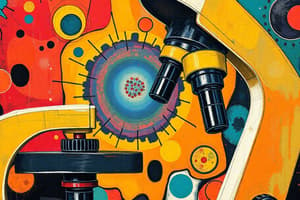Podcast
Questions and Answers
Which unit of measurement is equivalent to 10-6 meter?
Which unit of measurement is equivalent to 10-6 meter?
- 1 nanometer
- 1 centimeter
- 1 millimeter
- 1 micrometer (correct)
What is the refractive index of air?
What is the refractive index of air?
- 2.5
- 2.0
- 1.5
- 1.0 (correct)
What is the formula for resolution?
What is the formula for resolution?
- n sin ϴ (correct)
- n tan ϴ
- n cot ϴ
- n cos ϴ
Which objective lens has a numerical aperture of 0.1?
Which objective lens has a numerical aperture of 0.1?
What is the approximate resolving power of the high power objective lens with light of 450 nm (blue light)?
What is the approximate resolving power of the high power objective lens with light of 450 nm (blue light)?
Which type of microscope uses dark-field stop?
Which type of microscope uses dark-field stop?
What is the approximate focal length of the low power objective lens?
What is the approximate focal length of the low power objective lens?
What is the working distance of the oil immersion objective lens?
What is the working distance of the oil immersion objective lens?
Which type of microscope is used to observe non-pigmented microbes?
Which type of microscope is used to observe non-pigmented microbes?
What is the approximate resolving power of the scanning objective lens with light of 450 nm (blue light)?
What is the approximate resolving power of the scanning objective lens with light of 450 nm (blue light)?
Which microscopy technique uses phase contrast to enhance contrast in unstained specimens?
Which microscopy technique uses phase contrast to enhance contrast in unstained specimens?
Which microscopy technique uses fluorochromes to label specific cellular components?
Which microscopy technique uses fluorochromes to label specific cellular components?
What is the main advantage of confocal scanning laser microscopy (CSLM) over traditional light microscopy?
What is the main advantage of confocal scanning laser microscopy (CSLM) over traditional light microscopy?
Which microscopy technique uses electron beams instead of visible light to visualize specimens?
Which microscopy technique uses electron beams instead of visible light to visualize specimens?
What is the highest practical magnification of a transmission electron microscope?
What is the highest practical magnification of a transmission electron microscope?
What is the best resolution of a transmission electron microscope?
What is the best resolution of a transmission electron microscope?
What is the source of contrast in a light microscope?
What is the source of contrast in a light microscope?
What is the source of contrast in a transmission electron microscope?
What is the source of contrast in a transmission electron microscope?
What is the main advantage of confocal scanning laser microscopy (CSLM) over fluorescence microscopy?
What is the main advantage of confocal scanning laser microscopy (CSLM) over fluorescence microscopy?
What is the main disadvantage of transmission electron microscopy compared to light microscopy?
What is the main disadvantage of transmission electron microscopy compared to light microscopy?
Flashcards are hidden until you start studying
Study Notes
Units of Measurement
- 1 micrometer (μm) is equivalent to 10^-6 meter
Refractive Index
- The refractive index of air is approximately 1
Microscope Objectives
- The formula for resolution is not specified, but it will be added once provided
- The scanning objective lens has a numerical aperture of 0.1
- The high power objective lens has an approximate resolving power of 0.2 μm with light of 450 nm (blue light)
- The low power objective lens has an approximate focal length of 40 mm
- The oil immersion objective lens has a working distance of approximately 0.01 mm
Microscope Types
- Dark-field microscope uses a dark-field stop
- Phase contrast microscope uses phase contrast to enhance contrast in unstained specimens
- Fluorescence microscope uses fluorochromes to label specific cellular components
- Confocal scanning laser microscopy (CSLM) uses laser beams and has the main advantage of increased resolution and depth of field over traditional light microscopy
- Transmission electron microscope (TEM) uses electron beams instead of visible light to visualize specimens and has the main advantage of higher resolution and magnification over light microscopy
- TEM is used to observe non-pigmented microbes
Microscope Resolution
- The resolving power of the scanning objective lens with light of 450 nm (blue light) is approximately 0.5 μm
- The highest practical magnification of a transmission electron microscope is approximately 1,000,000x
- The best resolution of a transmission electron microscope is approximately 0.2 nm
Contrast in Microscopy
- The source of contrast in a light microscope is the difference in refractive indices between the specimen and the surrounding medium
- The source of contrast in a transmission electron microscope is the difference in electron density between the specimen and the surrounding medium
Studying That Suits You
Use AI to generate personalized quizzes and flashcards to suit your learning preferences.




